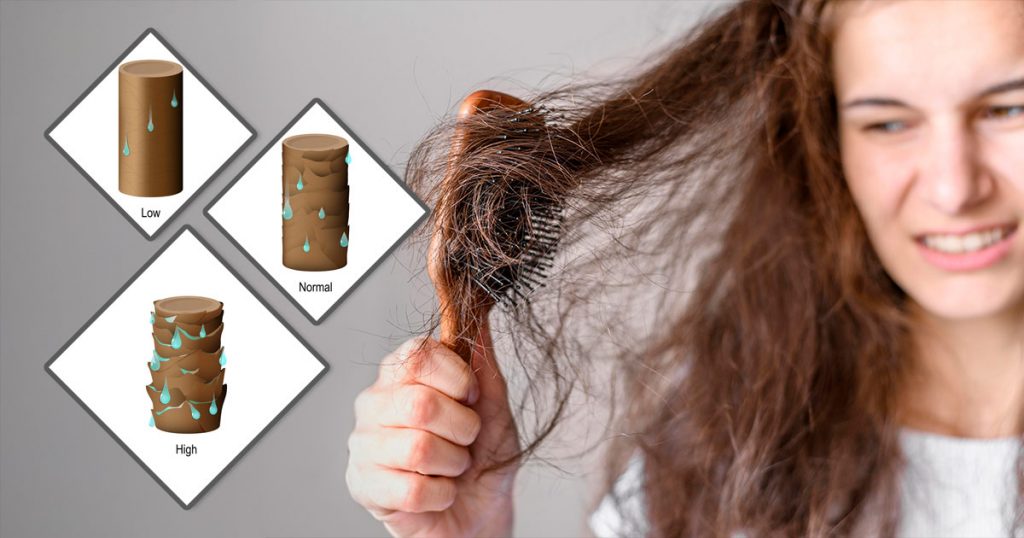High porosity hair means your hair’s outer layer, the cuticle, isn’t smooth and tightly packed. Instead, it has gaps, holes, or raised spots that let moisture and oils rush in fast, but they also escape just as quickly. It’s like trying to fill a bucket with tiny holes. No matter how much water you add, it keeps leaking out.
In fact, a study published in the International Journal of Trichology found that hair with higher porosity tends to have weaker tensile strength and more breakage compared to lower porosity hair. That explains why highly porous hair often looks and feels more fragile.
High Porosity Hair: Blessing, Curse, or Just Hair?
Some people are born with high porosity hair, especially if you have curly, coily, or kinky textures. But for most, it’s something that develops over time. Heat styling, chemical treatments, rough detangling, or even too much sun and wind can wear down your cuticle layer, making your hair more porous.
Now, is high porosity hair good or bad? Honestly, it’s not really either. It’s just a trait, not a flaw. One plus side is that your hair absorbs products like a sponge. Deep conditioners, oils, and treatments get in quickly, so you see results fast. The tricky part is keeping all that goodness locked in. Without the right high-porosity hair care, you’ll probably deal with dryness, frizz, and breakage more often than you’d like.
The good news is that when you manage it right, focusing on moisture, protection, and sealing, your hair can stay strong, soft, and healthy without feeling like a constant battle.
Signs You Have High Porosity Hair
Wondering if you really have high porosity hair? Here are seven clear signs to look for:
1. Your Hair Dries Very Fast After Washing
If your hair air-dries in 30 minutes or less, that’s a big hint. High porosity hair cannot hold water for long, so it dries much faster than low or normal porosity hair.
2. You Deal with Constant Frizz
Frizz happens when moisture from the air rushes into your hair’s open cuticles. High-porosity hair is like an open door; it easily soaks in humidity and swells, making frizz hard to control.
3. Your Hair Absorbs Products Instantly (But Still Feels Dry)
You can pile on leave-ins, oils, and creams, but your hair still feels parched. That’s because moisture escapes just as easily as it enters.
4. You Have a Lot of Breakage and Split Ends
Gaps in the hair shaft weaken the structure, making high porosity hair more fragile. If you notice tiny broken hairs on your shirt or split ends even after trims, high porosity could be the cause.
5. Your Hair Gets Tangled Easily
Open cuticles act like Velcro. Strands catch onto each other, causing knots and tangles. Detangling sessions become a real struggle if your porosity is high.
6. Color Fades Quickly from Your Hair
Because highly porous hair is so open, color molecules wash out faster. If you dye your hair and notice it losing vibrancy within a few washes, porosity could be the cause.
7. Your Hair Feels Rough or Dry Even When Wet
Normal hair feels slick when wet. High porosity hair, on the other hand, feels rough, almost like it’s missing its protective coating. That roughness is a key signal that the cuticle is damaged.
How to Treat and Manage High Porosity Hair
Now that you know you have high porosity hair, what should you actually do about it? Here’s how to treat and manage it to keep it looking and feeling healthy.
Focus on Moisture Retention
Since moisture leaves quickly, your main goal is trapping it inside the hair shaft.
- Use a hydrating leave-in conditioner right after washing.
- Seal with natural oils like avocado, jojoba, or argan oil.
- Follow up with a cream-based product if your hair still feels thirsty.
Layering products like this (known as the LOC method) works really well for high porosity hair.
Deep Condition Weekly
Deep conditioning is non-negotiable. Choose thick, nourishing masks with ingredients like shea butter, coconut oil, and hydrolyzed protein.
For better results, apply gentle heat while deep conditioning. You can use a heating cap or just wrap your hair in a warm towel.
Choose Gentle, Moisturizing Shampoos
Ditch harsh sulfates. They strip the little natural oils your hair desperately needs. Use a sulfate-free, hydrating shampoo, or try co-washing with cleansing conditioners.
Wash less often if you can. Over-washing dries out your hair even more.
Add Light Protein Treatments
Protein helps fill in those gaps in your hair’s structure. Use protein treatments about once or twice a month, depending on your hair’s needs.
If your hair feels mushy or overly soft, it might be craving protein.
Protect Your Hair at Night
Friction is the enemy. Sleep on a silk or satin pillowcase or wear a satin bonnet to cut down on moisture loss and prevent roughness.
You’ll notice less breakage and wake up with hair that feels softer and more manageable.
Avoid Heat and Chemicals When Possible
Every time you flat iron or bleach your hair, you’re adding more damage to already vulnerable strands.
If you must use heat, always apply a heat protectant first and keep temperatures as low as possible.
The High Porosity Hair Secret: Patience, Not Perfection
Managing high-porosity hair isn’t just about chasing moisture. It’s about recognizing that your hair’s needs can teach you a lot about patience, routine, and self-care. Quick fixes rarely work for hair like this, because real strength builds slowly.
Instead of trying to force your hair into behaving like someone else’s, focus on what your hair is telling you every day. If it needs gentleness, give it gentleness. If it needs structure, build it slowly.
High porosity hair reminds you that care isn’t about controlling something, it’s about working with it. That mindset will serve you far beyond just your hair.
